Abstract
The under-utilization of rice husk, a milling by-product, demands attention due to its widespread disposal and limited usage. This research aims to assess the physical properties and mechanical behavior of three rice husk varieties (F 2000, Orizyca, and Panorama 394), to determine their strength capacities and potential applications. Mechanical properties are evaluated through a non-standardized tension test using a universal machine. Subsequent analyses include measuring the moisture content following ASTM D1348, determining the particle size distribution through ASAE Standard S319, and establishing the bulk density using ASAE Standard S269 Method 4. Mechanical resistance in the rice husk varieties ranged from 60 MPa to 130 MPa, with a particle density exceeding 300 kg/m3 and an average apparent density of 140 kg/m3. Scanning electron microscopy revealed the husk structures, identifying epidermis, hypodermis, and sub-hypodermis layers. The mechanical stress of the Orizyca variety was 1.89 times higher than that of F 2000, and 1.18 times higher than that of Panorama 394. Potential applications include brick manufacturing and thermoformed materials for Orizyca and Panorama 394, while F 2000 could be utilized for producing fuel briquettes or cardboard, among other possibilities.
1. Introduction
Agro-industrial waste is often wasted and is mainly used for burning [1]; these natural renewable feedstocks are abundant in lignin, and various applications have been identified for them, as is the case for corn cob in the production of xylanase [2], which is used in waste degradation.
The agro-industrial by-product with the highest collection rate in Colombia is rice husk; rice production in Colombia in 2020 was 3,424,119 tons, which was generated by 596,414 ha planted according to DANE and FEDEARROZ; the approximate proportion of rice husk in paddy rice processing is 20–23%, which represents about 684,800 tons of the total production [3].
The husk left by the husking process in mills leads to secondary activities such as accumulation, packaging, and storage, owing to the husk’s mechanical characteristic of a low apparent density (40–200 kg/m3); for millers and producers, this is a setback to production and sustainability plans [4].
The preferred and most popular activity for reduction of the industrial by-product is open burning (incineration). The use of rice husks as a by-product of other agro-industrial processes could add additional income to the production process [5], improving sustainability and supporting the environment. The characterization of agro-industrial waste (rice husk) is important for the purpose of considering added value to this biomaterial. Rice husks have a calorific value of 3.3–3.6 cal/kg; they are used in unregulated activities that can generate high pollution, and their use as fuel or material to be incinerated is limited, producing an ash content of between 17% and 20%. A by-product of 90% silica is produced as a result of burning rice husks [6].
Research on rice husks focuses mainly on obtaining silica from the ashes produced by combustion; the process of obtaining it starts with alkaline extraction and subsequent acid precipitation. This procedure generates gels with up to 90% silica and a relative humidity of 3%, providing a source of silicates used in composites [7].
The processing of rice husks can produce various derivatives of hemicellulose such as xylitol, xylose, and furfural, as well as cellulose derivatives such as ethanol [8,9] and hexose, phenolic compounds from lignin, and finally other products such as silica [10].
Some materials consist of a matrix composed of a polymer resin to which natural fibers are added; these are intended to replace synthetic fibers (due to their low biodegradability) for a variety of uses such as glass fibers; in addition, composite materials often have better mechanical properties than their individual components. When a composite material has properties superior to those of its components, it is said to have synergy, which is an important property in determining which materials are likely to be used [11].
Basically, polymer composites consist of a polymer resin as a matrix with one or more fillers added to meet the objectives or requirements. Natural fibers often replace synthetic fibers, carbon fiber, or glass fiber due to their low wear. Composite materials often have better mechanical properties than their individual components [12,13].
The development of technologies for the agro-industrial processing of rice husks in a developing country such as Colombia will not only lead to increased availability of raw materials in the chemical and energy industry but will also provide the opportunity for higher revenues from rice milling.
The development of this research seeks the mechanical characterization of rice varieties, with Orizyca, Panorama 394, and F 2000 husk varieties coming from the Ibagué plateau, a place characterized by a warm climate, an elevation of 1285 m above sea level, and an average temperature of 21 °C; it is located in the center of Colombia, South America, and the geographical location coordinates of the harvesting location are 4°26′19.68″ N 75°11′43.44″ W. The chemical characteristics of the analyzed husk are described in the work carried out in [14].
This region ranks third in national rice production; the national production of rice in Colombia corresponds to 1,208,599 tons in 2021 and 912,267 tons in 2022; the Tolima region had a production of 403,028 tons in 2021 and 296,452 tons in 2022, with a variation equivalent to −26.4%. From the above we obtain that the production of rice husks was 88,667 tons in 2021 and 65,219 tons in 2022 [3]; therefore, the amount of rice husk from milling is an important factor when looking for alternative uses for this by-product. A better interpretation of the structure and mechanical characterization of rice husks can broaden the level of knowledge of structural modifications that may be needed for new applications such as biopolymers, nano-materials, husk-reinforced materials, or other larger macroscopic structures.
2. Materials and Methods
The materials to be evaluated are three varieties of rice husks (Orizyca, Panorama 394, and F 2000) from seeds sown in the department of Tolima. The determination of the physical properties of agro-industrial wastes such as rice husks will provide an adequate understanding of their utilization as a material; the physical characteristics of rice husks analyzed here are moisture content, particle size distribution, bulk density, and particle density.
2.1. Moisture Content
The amount of moisture present in the rice husks (Orizyca, Panorama 394, and F 2000) was determined according to ASTM D1348-94 [15], under the application of the “Test method b—heavy sample outside the oven”; for this, an initial sample of 10 g per husk was prepared and placed in an oven at 105 °C for an initial drying time of 120 min, then the weights of the samples were taken. Then, the husks were returned to the oven for an additional 60 min to resume weight measurement; this process was performed consecutively until a variation in weight of about 0.005 g was achieved [15].
The moisture content present in the different kinds of rice husks was calculated from the change in the weight of the initial sample and the change in the weight of the final sample (net dry sample). The determination of the difference in weight was obtained using a Radwag WTB 2000 digital balance (Poland), which provides a weight variant with an offset of 0.0001 g. The quantitative value was calculated according to
- = Original mass of sample plus container [kg];
- D = Net dry mass plus container [kg];
- T = Mass of the container [kg].
2.2. Particle Size
To determine the size distribution of the rice husk samples, the ASAE S319 method [16] was implemented. Initially, a constant mass of 100 g was maintained for all samples, which was arranged from the top sieve. American nomenclature sieves were used from 4, 8, 12, 16, 30, 60, and 100 with respective sieve apertures of 4.75, 2.36, 1.7, 1.18, 0.6, 0.25, and 0.15 (mm). The movement developed for the use of the sieves was generated downwards. A prolonged agitation with an interval of 15 min allowed for sedimentation of the different sizes, after which the masses of the individual sieves were measured.
2.3. Bulk Density
The bulk density of rice husk (Orizyca, Panorama 394, and F 2000) was obtained by applying the ASAE Standard S269.4. A 600 mL recipient was used for the husk volume; during the filling of the recipient, the husk was completely agglutinated by compression and intermittent agitation, the weight was determined, and the quantitative value was divided by the volume of the container to obtain the bulk density of the rice husk [17].
2.4. Particle Density
A pycnometer consisting of a pear-shaped flask with a ground-glass mouth and a cap with a capillary tube was used. This allowed the air bubbles to rise and concentrate in the neck, to be expelled when the stopper was placed. The correct use of the stopper prevented the presence of air bubbles from modifying the weight and therefore the density [18,19]. The measurement of the particle density was established for rice husks (Orizyca, Panorama 394, and F 2000) with a particle size between 0.25 and 0.15, ensured by obtaining the particle size and corresponding them to the 60 and 100 meshes, respectively, in order to reduce the spaces between pores and vertices inside the pycnometer. It was filled up to the surface of the container and a pressurized compaction was carried out with the plug, reducing the air and pore spaces; then, we proceeded to weigh and obtain the value for the husk.
2.5. Mechanical Properties
An evaluation of the specific mechanical properties of the rice husk was conducted using the universal testing machine HAIDA—HD-B604 S (China), to determine the material’s elastic and mechanical resistance properties. To guarantee the parameters of equality in the application of the tension test, two processes are available. Initially, the sizing of the specimens was standardized; for this purpose, a rectangular cut size was provided for the rice husk, as shown in Figure 1a; it had a longitudinal arrangement of 6 mm and width 3 mm. The rectangular arrangement of the rice husk guaranteed homogeneity in the tests.
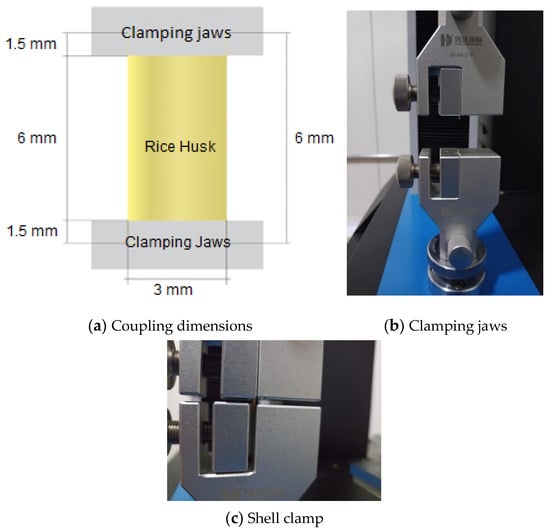
Figure 1.
Coupling on universal testing machine.
The characterization of the sample, the implementation measurement, and the parameters used for the husk tests, as well as the sizing of the cut specimen, were not standardized; however, they are supported by the parameters used in the research in [20]. For each of the rice husk varieties analyzed, 30 tests were carried out.
The rice husk placed between the clamps had a clamping dimension of 1.5 mm, and the pressure exerted on the clamp was homogeneous for all tests so that the threaded screw turned by 2.5 turns. For the clamping of the specimens, the clamps were selected and installed as shown in Figure 1b,c.
2.6. Micrographs of Rice Husk
Micrographs of the rice husk samples were taken by a standard digital microscope Olympo CX31 (Japan) as shown in Figure 2, where the awn and the rachilla can be observed; the edge is where the upper part of the husk ends and the rachilla is where the seed is held; using a magnification of 100× on the edge parallel to the cut, an external surface with micro lumps (epidermis) can be initially observed; in unequal conditions for a striated structure and in the presence of protuberances, part of the sub-hypodermis can also be observed [21].
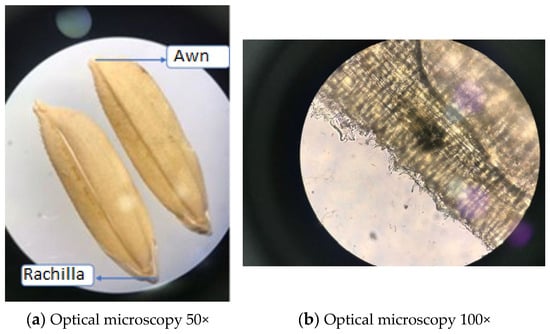
Figure 2.
Microscope images from Olympo CX31.
A Tescan Vega3 scanning electron microscope (SEM) (Japan) (was used to observe the three constituent layers of the rice husk (the epidermis, hypodermis, and sub-hypodermis [22,23]); to obtain the SEM images, it is necessary to prepare a sample of organic matter by centrifuging and spraying the conductive element using the COXEM equipment (Korea), to increase the ionic activity on the surface; this provides a greater insertion of the lens in the samples to be observed.
3. Results and Discussion
3.1. Results of Physical Analysis
Table 1 shows the physical characteristics of the different rice husk varieties analyzed; for this purpose, five similar tests were performed for each variety using a 600 mL vessel, under uniform conditions of room temperature (22 °C). The average results are illustrated, showing an average standard deviation of 0.045.

Table 1.
Values of the physical characteristics of the husks.
The moisture content of the rice varieties Orizyca, Panorama 394, and F 2000 are shown in Table 1. The moisture content analysis shows a 1.02% disparity between the Panorama 394 and Orizyca varieties, along with a corresponding 1.01% difference in moisture content between the Panorama 394 and F 2000 varieties, which makes them statistically similar; this aspect can be attributed to the uniformity of the agro-industrial process from harvesting to milling for each variety.
The bulk density was determined for the three varieties of husk under study; the Orizyca class had a higher value, and this characteristic was associated with the climatic conditions of the crop; as expressed in [17], the larger the particle size (husk), the smaller the empty space in the material and therefore the higher the bulk density.
For the types of husk studied (Orizyca, Panorama 398, and F 2000), an average apparent density of 142.7167 kg/m3 was found; this represents a difference of no more than 1% with respect to the results tabulated in Table 1. According to the research [24], the average value ranges between 120 kg/m3 and 579.18 kg/m3; this is an indication that there could be difficulties for the packaging, storage, and subsequent transport of the husks, due to the settlement that they adopt in the container once they are poured for storage or transport.
In relation to the particle density, a procedure was defined that involved the elimination of the spacings on the surface layer of the husk, followed by sieving to select the smallest size of husk that was compressed inside the pycnometer, eliminating the air present in the remaining pores. The average value for the apparent density was between 168.31 kg/m3 and 616.62 kg/m3 [25]. The average value of the analyzed samples was 315.049 kg/m3, with a variation of no more than 2.67% among these samples.
It can be observed that the parameters of bulk density and particle density were the characteristics that showed the greatest change between the different types of husk; this can be attributed to climatic conditions, crop location, fiber age, fiber thickness, and the technologies applied in post-harvesting [26].
The weight obtained per sieved mesh is shown in Figure 3. The #12 mesh size (1.7 mm) had the highest husk rice retention for the three evaluated husk classes (Orizyca, Panorama 394, and F 2000), with a combined average husk retention of 48.6%; up to mesh #30 (0.6 mm), there is a cumulative average husk retention of 79.83%. The rice husk with the highest retention percentage was Panorama394 by mass concentration in the #12 mesh (51.3%) and an accumulated retention up to the #30 mesh of 81.8%; in contrast, the F 2000 class presents a higher retention percentage in the #12 mesh (45.3%) and an accumulated retention up to the #30 mesh of 77.7%
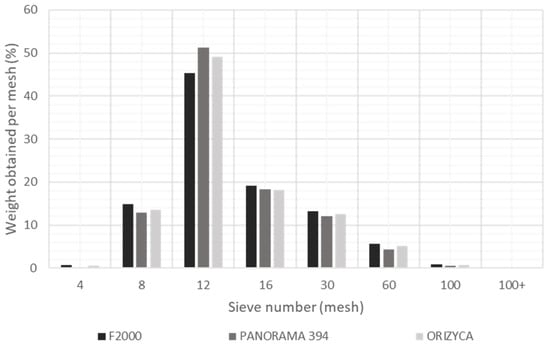
Figure 3.
Rice husk size distribution.
The difference between the two types of husk may be due to the fact that in Panorama 394, there was a greater presence of broken husk derived from the agro-industrial husking process; the values observed in Figure 3 are consistent with the results obtained in the evaluation of bulk density.
3.2. Results of Observations Using Scanning Electron Microscopy
Scanning electron microscopy was performed with magnifications between ×200 and ×5000 to establish the structure present in the rice husk; in Figure 4a,c, grooves are found along the longitudinal periphery of the husk; Figure 4b,d shows the cross-section of the rice husk, which comprises the outer part of the epidermis layer, a longitudinal structure called the hypodermis, and finally (on the opposite side of the inner layer) a layer with a porous structure, called the sub-hypodermis [27].
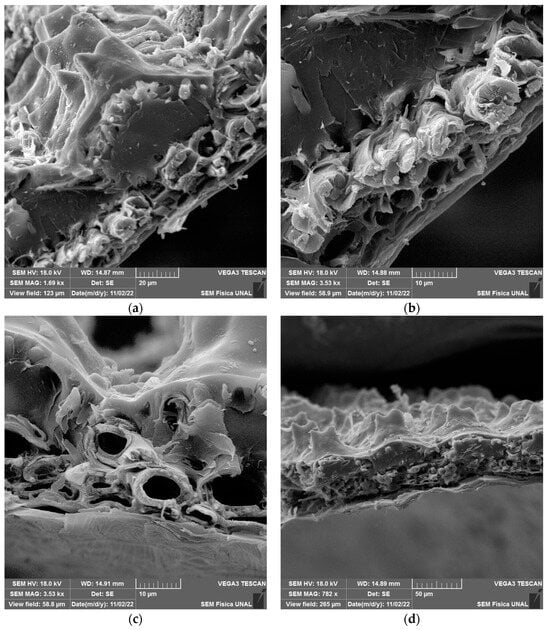
Figure 4.
Scanning electron microscopy images of the structure present in the rice husk: (a) 3000×, (b) 5000×, (c) 5000×, and (d) 2500×.
Figure 5a,b shows the outer surface layer of the rice husk, called the epidermis, characterized by a symmetrical structure made up of convex cells; these are separated by grooves and grains composed of silicon dispersed over the entire surface [27]; concave cells are present, with an average distance of 46.98 µm between them. Trichomes (acicular structures) can be identified in a non-regular and lower frequency, as shown in Figure 5c; these have an acicular structure with an average size of 200 µm.

Figure 5.
Scanning electron microscopy images of the structure present in the rice husk epidermis.
The morphology present in the hypodermis section is presented as an alignment of layers perpendicular to each other; as shown in Figure 6a, the hypodermis is intermediate between the epidermis and sub-hypodermis. The inner section of the grain epidermis, called the sub-hypodermis, is usually composed of thin-walled structures with small holes or openings [20]; these form a support and resilience structure which fulfils the function of protecting and supporting the load on the seed, as shown in Figure 6.
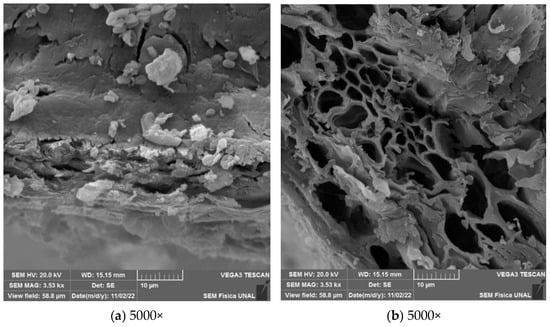
Figure 6.
Scanning electron microscopy images of the structure present in the rice husk: (a) hypodermis and (b) sub-hypodermis.
From the above observation and via comparison to [20], it was determined that the analyzed husk has a cellulose content of 45.84% and a lignin content of 26.10%. According to [27], lignin has binding properties that provide the fibrous consistency of plants; it performs the mechanical function of support, which provides rigidity to the cell wall and acts as a union [28]; cellulose is a structural polysaccharide in plants and is found in the wall of plant cells, where it is part of the supporting tissues and is also related to the susceptibility to hydrolysis.
3.3. Results of the Tension Test
The tensile test was used to determine the maximum stress in materials by producing tangential displacements in the intercellular spaces during application of the load [18]; this means that the more spaces that occur between the planes, the smaller the area supported by the load, which weakens the material. The maximum stress is obtained as the ratio of the load on the cross-sectional area of the rice husk; for the calculation and obtaining of all results of the tension tests, an area related to the width of the perpendicular husk of the specimen of 50 µm was established, as shown in Figure 7.
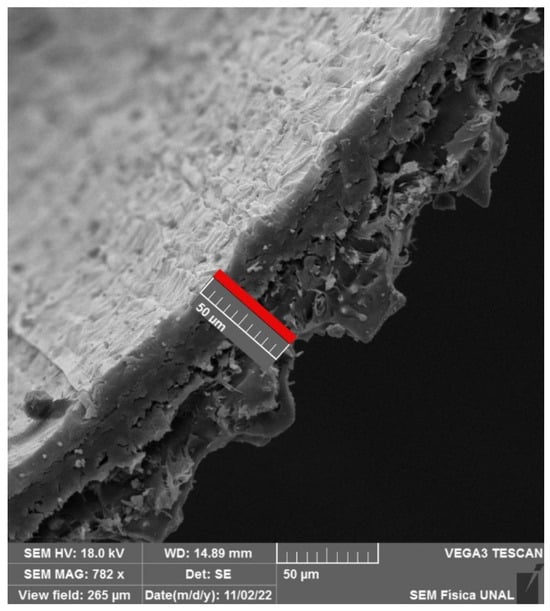
Figure 7.
Scanning electron microscopy image of the structure present in the cross-section of rice husks at 3000×.
For the development of the stress tests, 34 replicates were carried out for each variety of husk studied; the results are shown below. Figure 8 shows the stress and elongation data obtained for the rice husk varieties. The ultimate tensile stress for the Orizyca husk was 128 MPa and the elongation was up to 0.014 mm. The F 2000 variety showed an elongation of 0.009 mm, with a maximum stress of 67.23 MPa. The results obtained for Panorama 394 showed an elongation of 0.011 mm and a maximum stress of 108.83 MPa. Significant differences were found between stress and elongation for the rice husk varieties (p < 0.05).
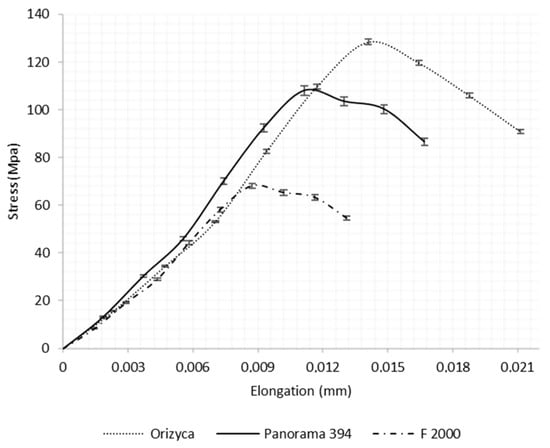
Figure 8.
Stress—displacement diagram for three rice husk varieties: Orizyca, Panorama 394, and F 2000.
Table 2 shows the values of the maximum stress and elongation. The results showed that the applied elongation significantly affected the maximum stress, with a significant difference (p < 0.05) between rice husk varieties. The rice husk type F 2000 was the least resistant among the evaluated varieties, showing a difference of 47% from the effort obtained for the Orizyca husk and 15% from that of the Panorama 394 husk; the displacement is directly proportional and presents the greatest difference (38%) between the Orizyca and F 2000 husks.

Table 2.
Elongation and stress of rice husks.
This variability is related to the recommended humidity for harvesting, which is between 22% and 24% for the F 2000 variety, 23% and 25% for the Panorama 394 variety, and 24% and 26% for the Orizyca variety [29,30,31]. In the Tolima plateau, rice harvesting is carried out in periods with diverse fluvial variation, which generally makes the relative humidity higher than recommended; for this reason, the varieties with greater susceptibility to this variable present lower stress.
The mechanical behaviors can be compared in Figure 8 This behavior can be explained according to the state of application of a triaxial force; when it occurs, the piece or specimen (shell) presents changes in its geometry, and the shell presents a constant volume during the whole test; however, a change can occur in the surface that supports the load, by means of alterations in section changes between the hypodermis and sub-hypodermis. The section variations develop very significant radial and circumferential stresses that when added to the longitudinal axial load provide a triaxial stress state that affects the stress [18,20,32,33].
Other works developed in relation to the mechanical characterization of rice husks have yielded results similar to those obtained here; in the work carried out in [18], the dimensions of the rice husk and the range of load values in specimens subjected to bending were established; in the work carried out in [20,34], similar methodologies were used with varieties native to southern China, finding slightly lower resistance magnitudes than those obtained with the varieties under study.
Rice husks as an agro-industrial waste can— due to their high silica content—be used in various applications such as in the manufacture of silica gels and silicon chips, the production of lightweight building materials and insulators, and as ingredients for lithium-ion batteries [35]; other identified uses are as a source of various nanomaterials such as nanosilica (NS), nanocarbon (NC), and nanozeolite (NZ) [36]; the use of rice husk as a reinforcement fiber in biodegradable bio-composites has also been proposed [37,38].
4. Conclusions
The behavior of rice husk layers is fundamental to understanding this material. The outer layer (the epidermis) grows longitudinally; on it, the load acted in the same direction; this can be understood as a matrix of composite materials in the hypodermis that is presented perpendicular to the growth. The load is applied in the direction that the fiber is oriented.
The differences between the maximum stresses for each kind of rice husk present a variation of about 2% and a complete difference between ranges, since the lowest was 67.627 MPa and the highest was 128.035 MPa.
The graphs of the tensile stress show a similar inclination between the varieties of husk analyzed but with a different maximum point of stress; likewise, the deformation behaves similarly between the classes of husk; the variation of the supported value may be due to the change in the particle density between the largest (Orizyca) and the smallest (F 2000).
The mechanical stress of the Orizyca variety was 1.89-fold larger than that of the F 2000 rice husk variety. Bricks and thermoformed materials are possible applications of Orizyca rice husks. Meanwhile, the F 2000 rice husk variety can be used to make fuel briquettes or cardboard, among others.
The environmental interest and the development of new materials research, focusing on the utilization of available agro-industrial wastes, provide opportunities for the use of natural fibers in composite materials. The physical parameters of the rice husks showed a variation of about 3%; the mechanical stress characteristics should be related to the recommended field moisture for the harvest of each rice variety.
The mechanical characterization of the varieties from the Tolima plateau makes the research carried out of interest, since these varieties are not found in other regions and their identification serves as a starting point for projecting various agro-industrial applications.
Author Contributions
Conceptualization and methodology, O.A., N.A. and I.X.C.; formal analysis, O.A. and N.A.; investigation, resources, O.A., N.A. and I.X.C.; writing—original draft preparation, O.A.; writing—review and editing, O.A., N.A. and I.X.C.; project administration, O.A. All authors have read and agreed to the published version of the manuscript.
Funding
This research received no external funding.
Data Availability Statement
The data presented in this study are available on request from the corresponding author.
Acknowledgments
The authors would like to thank the Research Department at the Universidad de Ibagué, Universidad Nacional de Colombia, as well as the Universidad del Tolima for their support in the development of this research.
Conflicts of Interest
The authors declare no conflicts of interest.
References
- Ejaz, U.; Sohail, M. Lignin: A renewable chemical feedstock. In Handbook of Smart Materials, Technologies, and Devices: Applications of Industry 4.0; Springer: Cham, Switzerland, 2021; pp. 1–15. [Google Scholar]
- Aftab, M.; Ejaz, U.; Pashameah, R.A.; Fatima, A.; Syed, J.; Ansari, I.; El-Bahy, Z.M. Utilization of Corncob as an Immo-bilization Matrix for a Xylanolytic Yeast Strain. Polymers 2023, 15, 683. [Google Scholar] [CrossRef] [PubMed]
- DANE. Encuesta Nacional de Arroz Mecanizado (ENAM), 2021. Available online: https://www.dane.gov.co/files/investigaciones/boletines/arroz/boletin_ENAM_Isem22.pdf (accessed on 20 September 2023).
- Qadir, N.; Wani, I.A. Physical properties of four rice cultivars grown in Indian temperate region. Appl. Food Res. 2023, 3, 100280. [Google Scholar] [CrossRef]
- Millogo, Z.E.N.; Appiah-Effah, E.; Akodwaa-Boadi, K.; Antwi, A.B.; Ofei-Quartey, M.N.L. The synergy between pristine rice husk biomass reuse and clean energy production. Bioresour. Technol. Rep. 2022, 19, 101179. [Google Scholar] [CrossRef]
- Liberalesso, T.; Tassi, R.; Ceconi, D.E.; Allasia, D.G.; Arboit, N.K.S. Effect of rice husk addition on the physicochemical and hydrological properties on green roof sub-strates under subtropical climate conditions. J. Clean. Prod. 2021, 315, 128133. [Google Scholar] [CrossRef]
- Dizaji, H.B.; Zeng, T.; Hölzig, H.; Bauer, J.; Klöß, G.; Enke, D. Ash transformation mechanism during combustion of rice husk and rice straw. Fuel 2021, 307, 121768. [Google Scholar] [CrossRef]
- Fu, G.Z.; Chan, A.W.; Minns, D.E. Life Cycle assessment of bio-ethanol derived from cellulose. Int. J. Life Cycle Assess. 2003, 8, 137–141. [Google Scholar] [CrossRef]
- Ejaz, U.; Rashid, R.; Ahmed, S.; Narejo, K.K.; Qasim, A.; Sohail, M.; Ali, S.T.; Althakafy, J.T.; Alanazi, A.K.; Abo-Dief, H.M.; et al. Synthesis of methylcellulose-polyvinyl alcohol composite, biopolymer film and thermostable enzymes from sugarcane bagasse. Int. J. Biol. Macromol. 2023, 235, 123903. [Google Scholar] [CrossRef]
- Yeboah, W.O.; Kwofie, E.M.; Wang, D. Circular bioeconomy potential of rice husk as a bioplastic resource: Techno-environmental assessment. Bioresour. Technol. Rep. 2022, 20, 101248. [Google Scholar] [CrossRef]
- Aramwit, P.; Sheng, D.D.C.V.; Moorthy, G.K.; Guna, V.; Reddy, N. Rice husk and coir fibers as sustainable and green reinforcements for high performance gypsum composites. Constr. Build. Mater. 2023, 393, 132065. [Google Scholar] [CrossRef]
- Ratna, A.S.; Ghosh, A.; Mukhopadhyay, S. Advances and prospects of corn husk as a sustainable material in composites and other technical applications. J. Clean. Prod. 2022, 371, 133563. [Google Scholar] [CrossRef]
- Valverde, A.; Sarria, B.; Monteagudo, J.P. Análisis comparativo de las características fisicoquímicas de la cascarilla de arroz. Sci. Tech. 2007, 13, 255–260. [Google Scholar]
- Carrillo, D.; Julio, C. Modelo de Agronegocio para la Produccion de Arroz Sostenible Bajo las Condiciones Agroclimáticas de la Meseta de Ibague en el Departamento del Tolima, Colombia. Master’s Thesis, Maestría en Gestión de Agronegocios y Mercados sostenibles, Centro Agronómico Tropical de Investigación y Enseñanza, Turrialba, Costa Rica, 2023. [Google Scholar]
- D1348—94; Standard Test Methods for Moisture in Cellulose, Designation. ASTM International: West Conshohocken, PA, USA, 2003.
- Ijabo, O.; Agbede, I. Suitability of techniques for analyzing particle size of rice husk ash (RHA) from sieve analysis data. World 2011, 2, 652–659. [Google Scholar] [CrossRef]
- Zhang, Y.; Ghaly, A.E.; Li, B. Physical properties of rice residues as affected by variety and climatic and cultivation conditions in three continents. Am. J. Appl. Sci. 2012, 9, 1757–1768. [Google Scholar]
- Jearanaisilawong, P.; Eahkanong, S.; Phungsara, B.; Manonukul, A. Determination of in-plane elastic properties of rice husk composite. Mater. Des. 2015, 76, 55–63. [Google Scholar] [CrossRef]
- Araque, O.; Nelson, A.; Laura, G. Mechanical behavior of briquettes made from a mixture of sawdust and rice husks for commercialization. Resources 2022, 11, 32. [Google Scholar] [CrossRef]
- Chen, Z.; Xu, Y.; Shivkumar, S. Microstructure and tensile properties of various varieties of rice husk. J. Sci. Food Agric. 2017, 98, 1061–1070. [Google Scholar] [CrossRef] [PubMed]
- Onyelowe, K.C.; Obianyo, I.I.; Onwualu, A.P.; Onyia, M.E.; Moses, C. Morphology and mineralogy of rice husk ash treated soil for green and sustainable landfill liner construction. Clean. Mater. 2021, 1, 100007. [Google Scholar] [CrossRef]
- Santhosh, M.; Karthikeyan, G.; Sasikumar, R.; Hariharan, R.; Mohanraj, R. Mechanical and morphological behaviour of rice husk/prosopis juliflora reinforced bio composites. Mater. Today Proc. 2020, 27, 556–560. [Google Scholar] [CrossRef]
- Fávaro, S.L.; Lopes, M.S.; Neto, A.G.V.d.C.; de Santana, R.R.; Radovanovic, E. Chemical, morphological, and mechanical analysis of rice husk/post-consumer polyethylene composites. Compos. Part A Appl. Sci. Manuf. 2010, 41, 154–160. [Google Scholar] [CrossRef]
- Anando, A.I.; Ehsan, M.M.; Karim, R.; Bhuiyan, A.A.; Ahiduzzaman; Karim, A. Thermochemical pretreatments to improve the fuel properties of rice husk: A review. Renew. Energy 2023, 215, 118917. [Google Scholar] [CrossRef]
- Emdadul, H.; Rashid, F.; Aziz, M. Gasification and power generation characteristics of rice husk, sawdust, and coconut shell using a fixed-bed downdraft gasifier. Sustainability 2021, 13, 2027. [Google Scholar]
- Satbaev, B.; Yefremova, S.; Zharmenov, A.; Kablanbekov, A.; Yermishin, S.; Shalabaev, N.; Satbaev, A.; Khen, V. Rice husk research: From environmental pollutant to a promising source of organo-mineral raw materials. Materials 2021, 14, 4119. [Google Scholar] [CrossRef] [PubMed]
- Wrigley, C.W.; Corke, H.; Seetharaman, K.; Faubion, J. (Eds.) Encyclopedia of Food Grains; Academic Press: New York, NY, USA, 2015. [Google Scholar]
- Ejaz, U.; Sohail, M. Supporting role of lignin in immobilization of yeast on sugarcane bagasse for continuous pectinase production. J. Sci. Food Agric. 2020, 101, 1709–1714. [Google Scholar] [CrossRef] [PubMed]
- Fedearroz. Variedad Fedearroz, 2000. Available online: https://fedearroz-website.s3.amazonaws.com/media/documents/Ficha_tecnica_Fedearroz_2000.pdf (accessed on 9 December 2023).
- ICA. Variedad Orysica. Available online: https://repository.agrosavia.co/bitstream/handle/20.500.12324/32676/39706_23753.pdf?sequence=1&isAllowed=y (accessed on 9 December 2023).
- Pajonales. Semilla de arroz Panorama 394. Available online: https://www.pajonales.com/wp-content/uploads/2020/06/Ficha-te%CC%81cnica-Panorama-394-Aprobada-2.pdf (accessed on 9 December 2023).
- Namfon, S.; Meerasri, J.; Sothornvit, R. Rice husk nanocellulose: Extraction by high-pressure homogenization, chemical treatments and characterization. Carbohydr. Polym. Technol. Appl. 2023, 6, 100353. [Google Scholar]
- Hincapié-Rojas, D.F.A.; Rosales-Rivera, P.; Pineda-Gomez, P. Synthesis and characterisation of submicron silica particles from rice husk. Green Mater. 2018, 6, 15–22. [Google Scholar] [CrossRef]
- Molina, A. Caracterización Mecánica de la Cascarilla de Arroz, Colombia. Ph.D. Thesis, Mechanical Engineering, Universidad de Ibagué, Ibagué, Colombia, 2023. [Google Scholar]
- Pode, R. Potential applications of rice husk ash waste from rice husk biomass power plant. Renew. Sustain. Energy Rev. 2016, 53, 1468–1485. [Google Scholar] [CrossRef]
- Ali, S.H.; Emran, M.Y.; Gomaa, H. Rice husk-derived nanomaterials for potential applications. Waste Recycl. Technol. Nanomater. Manuf. 2021, 13, 541–588. [Google Scholar]
- Rannaste, E. Usage of Rice Husk as a Filler Material in PHBV Based Biopolymer. Ph.D. Thesis, Oulu University of Applied Sciences, Oulu, Finlandia, 2015. [Google Scholar]
- Faruk, O.; Bledzki, A.K.; Fink, H.-P.; Sain, M. Biocomposites reinforced with natural fibers: 2000–2010. Prog. Polym. Sci. 2012, 37, 1552–1596. [Google Scholar] [CrossRef]
Disclaimer/Publisher’s Note: The statements, opinions and data contained in all publications are solely those of the individual author(s) and contributor(s) and not of MDPI and/or the editor(s). MDPI and/or the editor(s) disclaim responsibility for any injury to people or property resulting from any ideas, methods, instructions or products referred to in the content. |
© 2024 by the authors. Licensee MDPI, Basel, Switzerland. This article is an open access article distributed under the terms and conditions of the Creative Commons Attribution (CC BY) license (https://creativecommons.org/licenses/by/4.0/).